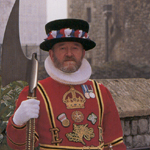Talk:Stephenson:Neal:Quicksilver:3:Jack Ketch (Neal Stephenson)
From the Quicksilver Metaweb.
Jack Ketch was a real, London executioner who was notorious for his drunkeness and cruelty from about 1678 to 1686. Many eye witness accounts exist of his public whippings, and scores of executions by hanging or beheading. The most famous of these is the gruesome story of the botched beheading of the Duke of Monmouth on July 15, 1685. The Beefeaters at the Tower of London still tell this story on their guided tours in order to gross out the tourists. For more information, go to this link: http://www.hangman.info/hangman2.htm
Above Link seems broken. 
A Beefeater
Beefeater tales: The Tower is where Anne Bolyn, the Duke of Monmouth, Guy Fawkes (who was brutally tortured) and hundreds of other unfortunate souls were executed. The poor Duke of Monmouth was beheaded by Jack Ketch, the infamous and unreliable executioner at the Tower. After several unsuccessful but painful blows with his axe, Ketch had to finish the Duke with a knife. After the execution, it was suddenly realized that there were no "official" portraits of the Duke, so his head had to stitched back on by the Royal Surgeon, the scar covered with an ascot, and the portrait hurriedly painted. The portrait can be seen today at the Royal Portrait Gallery.
- Hang em High Perhaps the most famous of England's executioners was Jack Ketch. He was surprisingly inefficient at dispatching his victims despite all the practice he had. Ketch was the official executioner from 1663 until 1686, some 23 years. Even after his death successive hangmen were nicknamed "Jack Ketch" and mobs would point out "Jack Ketch" in the street and mothers would frighten their naughty children into obedience by threatening them with "Jack Ketch" and his rope. The name survives even today, the hangman in the children's Punch and Judy seaside show always being called "Jack Ketch." Ketch managed to make a mess in fairly horrendous fashion of two of his victims in the last three years of his career. He was tasked with dispatching Lord William Russell, a son of the First Duke of Bedford, who had been accused of a plot to assassinate Charles II but the evidence was very slim. He was taken to Lincoln's Inn fields in London in July 1683 and Lord Russell, fearing the worst, gave Ketch 10 guineas to do the job efficiently. However, the first blow of the axe only wounded Lord Russell. The condemned man looked up at Ketch and said, "You dog, did I give you ten guineas to use me so inhumanely?" Ketch landed another blow but the head was still not severed from the body and it took another two strikes before the job was done, making four in all. The gossips said that Ketch had been paid twice as much by Lord Russell's opponents to make a mess of the job but this was almost certainly not the case. Ketch blamed Lord Russell for having moved his head at the last moment.
- The Newgate Calendar and JOHN PRICE, COMMONLY CALLED JACK KETCH: There is no single book called The Newgate Calendar. The first readily available accounts of crimes and criminals in England were broadsheets and chapbooks, produced in significant numbers from the beginning of the eighteenth century. A broadsheet was a single sheet of paper with typically four pages printed on each side in such a way that the buyer could fold, stitch and cut it to form a booklet; a chapbook was one of these sold ready made up. Both were very cheap -- a penny or so -- and were sold at fairs, by itinerant pedlars, and particularly, at executions. Many of these included accounts of the execution itself, including the last words of the condemned man before he had even spoken them.
- Jack Ketchs Gallows Jig A Tale of Sex and Death by Gavin Kostick
FYI: A Beefeater must serve a minimum of twenty years in the British Army and display "exemplary service." The Beefeaters live on the historic Tower of London grounds with their families, a prestigious honor. There are only 40 Beefeaters at any given time. Their responsibilities vary from guiding tourist to caring for the traditional large black ravens. The rumor has been, for hundreds of years, that when there are no more ravens left at the Tower, the Kingdom will fall. So to make sure, they clip the wings of these huge birds. Though there are rumors of wired feet and Euro-Disney animatronics. Perfidious Albion indeed.